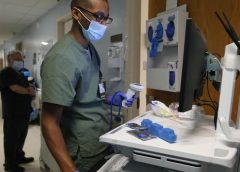
Hospitals in WNY and beyond still spending BIG on travel workers | Business Local
[ad_1]

The headline on a story in The Wall Street Journal in late July read, “Traveling-Nurse Bubble Bursts,” noting the pandemic days when a travel nurse could make $10,000 per week were ending.
But even if wages are no longer an annualized half-million dollars, hospitals in Western New York and across the state are still spending big – with a capital B – on temporary employees to fill staffing gaps.
The News’ Buffalo Next team covers the changing Buffalo Niagara economy. Get the news in your inbox 5 days a week.
Consider the situation at Kaleida Health, Western New York’s largest health system that is currently engaged in heated labor negotiations with two unions representing two-thirds of its payroll.
How much Kaleida is spending on agency workers has come up several times as the talks have spilled into public view.
According to Kaleida, its agency expense per month is running nearly seven times higher than a year ago , a cost that surged amid the Omicron wave early this year and has continued deeper into the year. Kaleida is on track to spend $97 million this year on agency costs, up from just $14.5 million in 2021.
Kaleida’s rival, Catholic Health System, also has seen higher costs for travel workers this year – at least in the first three months of 2022.
Catholic Health said it used temporary agency staffing for about 500 full-time-equivalent positions in its facilities during the first quarter of this year, according to a required disclosure to investors after a bond issuance this year.
At an average rate of more than $150 an hour, that cost Catholic Health more than $34.5 million in the first quarter, an increase of $24.8 million, or 255%, compared with the first three months of 2021.
“The rate paid for agency nurses has risen significantly over the past two years, due to supply and demand forces within the nursing labor market,” Catholic Health said in the disclosure.
Catholic Health and others have been racing to hire new nurses to lessen their reliance on travelers. Catholic Health said it has made some progress on that front: In early June, for instance, the health system had one of its largest-ever weekly orientation classes of more than 100 new employees.

Registered respiratory therapist Mario Bynum, a traveler from Arkansas who was filling in due to a shortage of staff, prepares a treatment for a patient in the emergency room at Brooks-TLC Hospital in Dunkirk in this file photo from late December 2021.
Derek Gee / Buffalo News
Our neighbors to the east also have more travelers working in their hospitals.
Iroquois Healthcare Association, which represents more than 50 health systems across 32 upstate counties, east of Rochester, regularly surveys its membership and has only seen the costs for staffing continue to grow.
In the association’s mid-year financial survey, the 52 hospitals that responded are collectively expected to spend more than $1.2 billion on contingent staffing this year, which would be a 50% increase from what was spent last year.
And while the group’s members say travel nurse wages are declining a little bit, the sheer volume of travelers needed has increased costs for hospitals.
“They’re going into their reserves to pay staffing costs to pay agency nurses,” said Gary Fitzgerald, president and CEO of Iroquois Healthcare Association.
Looking nationally, massive health care staffing company AMN Healthcare Services in early August reported second-quarter travel nurse staffing revenue of nearly $776 million, up 70% from about $458 million a year earlier.
But the second-quarter figure was down 20% from the $970 million in travel nurse staffing revenue during the first quarter.
Yes, bill rates for travel nurses have indeed declined, but demand is still strong.
“At these high levels of demand and the trajectory of bill rates for future placements, we believe the average bill rate will bottom out slightly higher than we previously expected,” AMN CEO Susan R. Salka said on the company’s earnings call.
All this staffing talk comes while we’re well into the process for the state-mandated clinical staffing committees.
The committees, formed at every New York hospital at the start of 2022, include at least one-half clinical staff members and up to one-half hospital administrators. Each committee is tasked with developing and implementing an annual clinical staffing plan, which includes specific staffing ratios such as how many patients are assigned to each registered nurse.
Each hospital was required to submit their plan to the state by July 1. Those plans, which the state posted online July 29, can be viewed at www.health.ny.gov/facilities/hospital/staffing_plans/.
The plans must be implemented by Jan. 1.
For Kaleida, that means creating 436 full-time-equivalent positions across Buffalo General/Gates Vascular Institute, Millard Fillmore Suburban Hospital/DeGraff Medical Park and Oishei.
Kaleida said those positions will cost it $30 million a year.
But hey, it’s less than $100 million this year for travelers.
Want to know more? Three stories to catch you up:
• A road increasingly traveled: Fed-up nurses turn to lucrative travel work. But how long can it last?
• Kaleida’s ‘fragile’ finances and burned-out employees making labor deal difficult to reach
• Kaleida could add hundreds of jobs under state-mandated staffing plan. Labor unions looking to build on that
Welcome to Buffalo Next. This newsletter from The Buffalo News will bring you the latest coverage on the changing Buffalo Niagara economy – from real estate to health care to startups. Read more at BuffaloNext.com.
THE LATEST
Recent news tied to Buffalo Niagara’s economy
The last pieces of available land at the Buffalo Lakeside Commerce Park could have a new owner soon.
Developer Douglas Jemal has acquired another downtown Buffalo property, this time buying the Dragon Express building on the 500 block of Main Street.
Developer Sam Savarino plans to convert the Kenmore Presbyterian Church into apartments.
First round of legalization plan will bring 11 recreational pot stores to Western New York.
Longtime M&T chairman Robert Wilmers’ famous bike now on display in Buffalo.
A Fortune 500 company is backing plans to build a cannabis production facility near the Lake Erie shoreline off Route 5.
Local unemployment is on the rise after four straight months of sluggish hiringbut it’s still low by historic standards.
As contract talks continue, the unions representing most Kaleida Health workers plan to hold a strike authorization vote in mid-September.
Roswell Park Comprehensive Cancer Center opened its expanded facility for patients with head and neck cancer.
Part of the reason a labor deal has been difficult to reach at Kaleida? A health system with ‘fragile’ finances and burned-out employees.
But Kaleida and the unions agree on one thing: WNY hospitals need more state funding.
ICYMI
Five reads from Buffalo Next:
1. WNY Prosperity Fellowship boosts student leaders: The goal is to grow new businesses and keep them here – a key part of efforts to build a vigorous startup community in a region where new business creation lagged behind the rest of the country for years.
2. Ever so slowly, a few more homes are coming up for saleeasing the severe supply crunch that has helped push up home prices to record levels over the last few years. But it’s a small increase, leaving sellers still with the upper hand, and it’s not big enough to stem the rise in prices, either.
3. Workers are hard to find, and it’s putting a damper on hiring across the Buffalo Niagara regionnot because there’s a lack of jobs, but because there’s a lack of workers with the right skills.
4. ‘Cancer didn’t stop during Covid’: Roswell Park’s patient volume in its last fiscal year exceeded its pre-pandemic totals two years ago. That, coupled with full restoration of operating support from New York, led to a surplus.
5. Why are car washes popping up all over the Buffalo Niagara region?: There’s a gusher of money from deep-pocketed investors that’s helping regional and national chains expand into new markets, while mom-and-pop operators also are trying to cash in.
The Buffalo Next team gives you the big picture on the region’s economic revitalization. Email tips to buffalonext@buffnews.com or reach Deputy Business Editor David Robinson at 716-849-4435.
Email tips to buffalonext@buffnews.com.
[ad_2]
Source link


